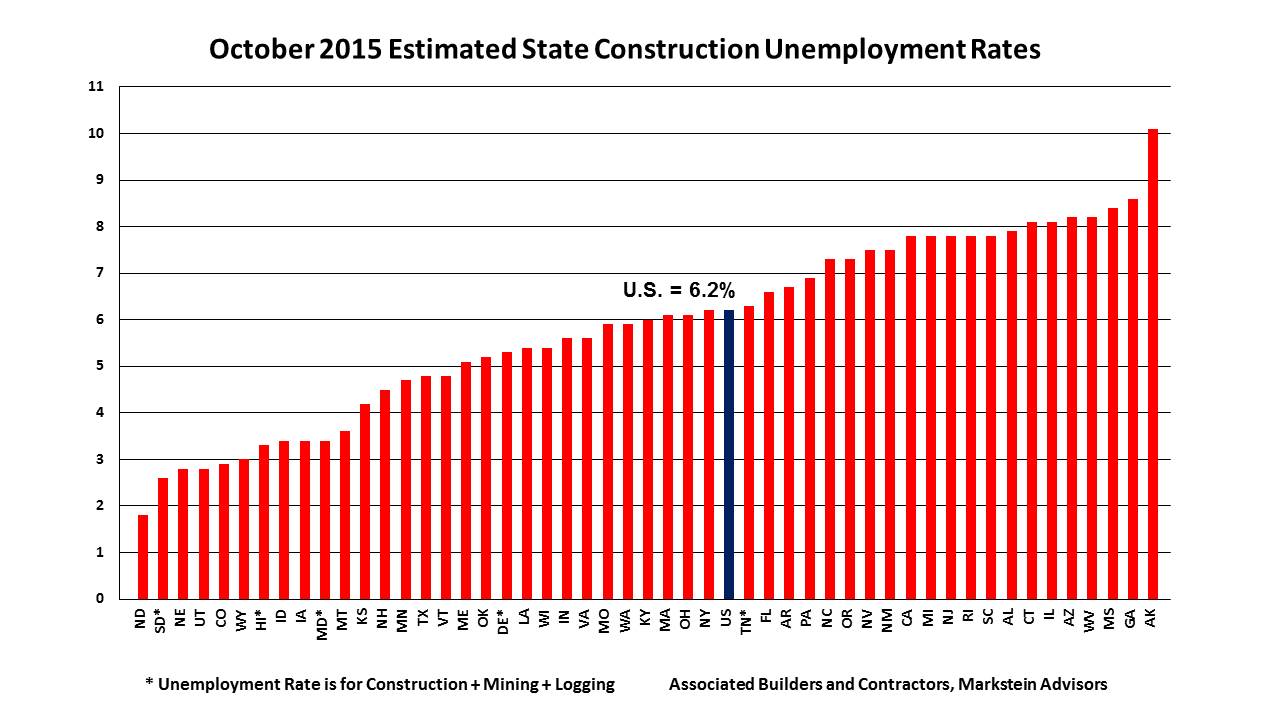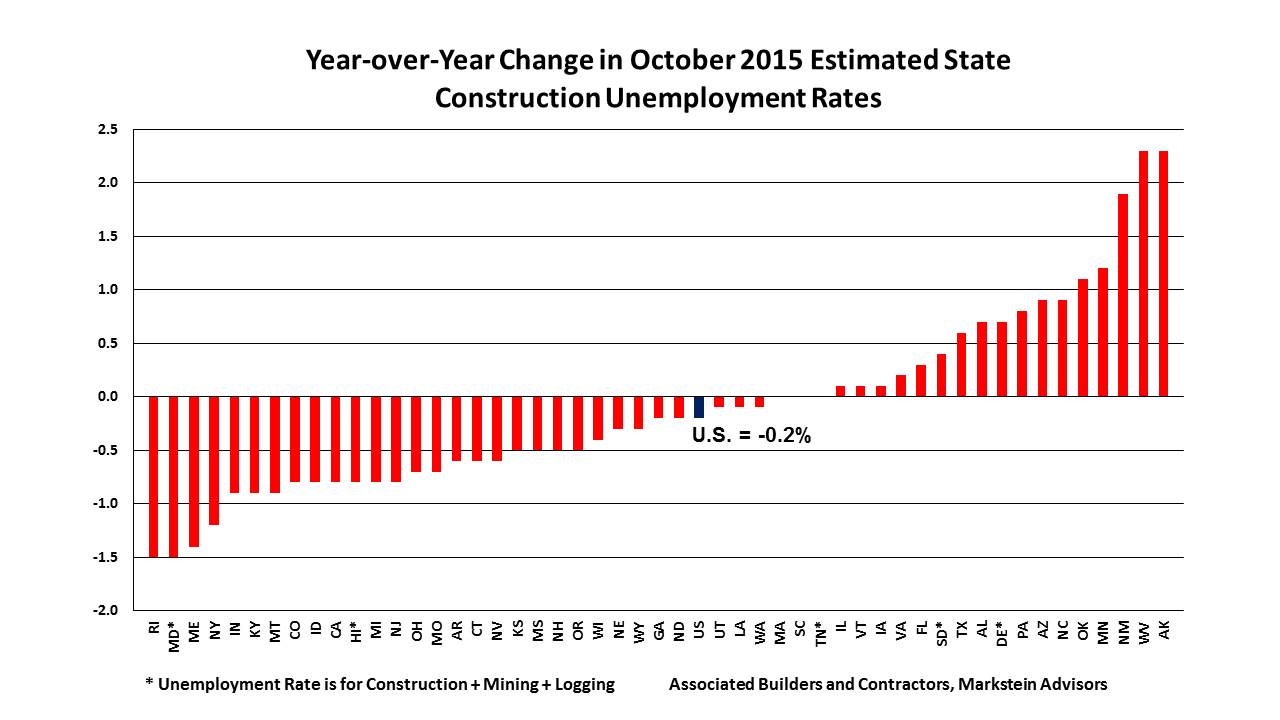October Construction Unemployment Rates Improve in 30 States from 2014
By Bernard M. Markstein, Ph.D.
Overview
October was another positive month for construction and construction unemployment rates around much of the country. Year-over-year, not seasonally adjusted (NSA) construction unemployment rates for the country and 30 states were lower in October this year. Year to date, construction has added 159,000 seasonally adjusted (SA) jobs throughout the country. Meanwhile, NSA jobs nationally increased by 228,000 from October 2014 to October 2015. Additionally, SA construction spending in October increased 1 percent from September according to the Census Bureau’s Dec. 1 release. Year-to-date NSA construction spending as of October was up 10.7 percent compared to the same period a year ago.
The national October NSA construction unemployment rate has increased from the previous month in 10 of the previous 15 years. It must be remembered that NSA unemployment rates tend to have a seasonal pattern. This is the reason that year-over-year comparisons of the NSA rates are preferred over monthly rate comparisons. Consequently, monthly comparisons should be used with care.
This October, the national rate rose 0.7 percent to 6.2 percent. The estimated NSA construction unemployment rate increased for 38 states from September. The NSA construction unemployment rates for three states—Maryland, Rhode Island and Vermont—were unchanged from the previous month.
View states ranked by their construction unemployment rate.
View states ranked by their year-over-year improvement in construction employment.
View states ranked by their monthly improvement in construction employment.
View each states' unemployment rate for all industries.
The Top Five States
The five states with the lowest construction unemployment rates in order were:
1. North Dakota
2. South Dakota*
3. Nebraska and Utah (tie)
5. Colorado
* Unemployment rate is for construction, mining, and logging combined
The top four states—North Dakota, South Dakota, Nebraska and Utah—were among the top five in September. All of the top five states are in the same geographic area, although in two separate census regions (Mountain and West North Central). These states all benefit from agriculture plus energy and mineral extraction. All of these states have low overall unemployment rates. Thus some of those who lost their jobs in construction may have easily found jobs elsewhere in the area. Further, some may have left the area in search of work, keeping the construction unemployment rate down.
North Dakota maintained its number-one position for the fourth month in a row. Also, North Dakota’s estimated construction unemployment rate of 1.8 percent was down 0.2% on a year-over-year basis. This follows four months of year-over-year increases.
South Dakota moved up to second place position with a construction unemployment rate of 2.6 percent from third place in September based on revised data (it was previously reported in second place). This was despite a 0.4 percent increase in its rate from October 2014.
Nebraska tied with Utah for third place with a 2.8 percent rate, up from fifth place in September based on revised data (previously reported in seventh place). Utah was up from fourth place in September.
Colorado jumped up to fifth lowest estimated construction unemployment rate in October with a 2.9 percent rate from eighth lowest in September. Colorado had the largest monthly drop in its rate, along with Idaho (down 0.7 percent).
Wyoming, which had the second lowest rate in September based on revised data (previously reported as third lowest) dropped to sixth lowest rate in October with a 3 percent rate.
Maryland, which was previously reported in fifth place in September and was lowered to sixth place based on revised data, slipped into a tie for eighth place with Idaho and Iowa with a 3.4 percent rate.
View the top five and bottom five states ranked by construction unemployment rate.
The Bottom Five States
The five states with the highest construction unemployment rates (from lowest to highest) were:
46. Arizona and West Virginia (tie)
48. Mississippi
49. Georgia
50. Alaska
Two of the five states with the highest estimated construction unemployment rates in October—Georgia and West Virginia—were among the five highest in September. Rhode Island, which had the highest construction unemployment rate in August and September, was tied for ninth highest with four other states (California, Michigan, New Jersey and South Carolina) in October with a 7.8 percent rate. The state also tied with Maryland for the largest year-over-year drop in its construction unemployment rate (down 1.5 percent).
Alaska took over as the state with the highest estimated construction unemployment rate in October. The rise into double digits (10.1 percent) for Alaska’s construction unemployment rate is the norm for that time of year for that state. Since 2002, Alaska’s October rate has been in double digits every year except for last year. With the exception of the 2014 estimate, this October’s rate is the state’s lowest rate for the month since 2001.
Georgia had the second highest rate in October (8.6 percent). In September, it had the third highest based on revised data (previously reported as tied with Connecticut for second highest). Connecticut, which had the second highest rate in September, moved to sixth highest (8.1 percent), tied with Illinois.
Mississippi’s 8.4 percent estimated construction unemployment rate was the third highest rate. In September, the state had the sixth highest rate based on revised data (previously reported as fifth highest), tied with Arizona. In October, Arizona was tied with West Virginia with the fourth highest construction unemployment rate of 8.2 percent. West Virginia also had the fourth highest unemployment rate in September. West Virginia tied with Alaska for the largest year-over-year increase in its rate—up 2.3 percent. West Virginia’s year-over-year unemployment rate has increased for eight months in a row.
View regional breakdowns of the construction unemployment rates of each state.
To better understand the basis for calculating unemployment rates and what they measure, see the article Background on State Construction Unemployment Rates.

